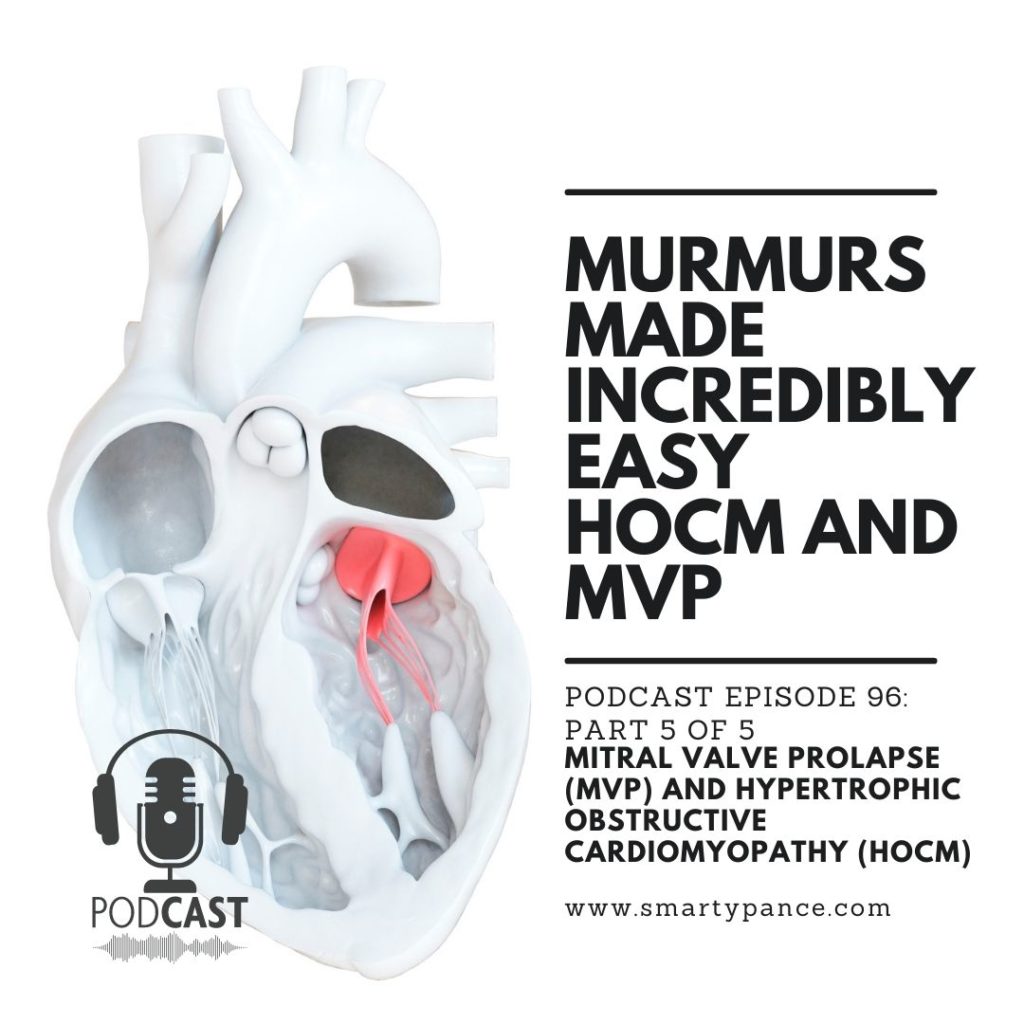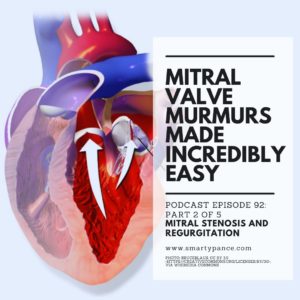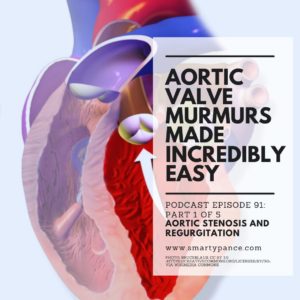Podcast Episode 96: Murmurs Made Incredibly Easy (Part 5 of 5) – MVP and HOCM
Description
<figure class="alignright size-large is-resized">
 </figure>
</figure>Welcome to episode 96 of the Audio PANCE and PANRE PA board review podcast.
Today is part five of this fabulous five-part series with Joe Gilboy PA-C, all about cardiac murmurs. In this week’s episode of the Audio PANCE and PANRE podcast, we continue our discussion of cardiac murmurs with a focus on Mitral Valve Prolapse (MPV) and Hypertrophic Obstructive Cardiomyopathy (HOCM).
We’ll cover the ins and outs of these two NCCPA content blueprint murmurs and learn how to identify and differentiate them from other types of murmurs.
If you haven’t already, make sure to listen to our previous podcast episodes where we covered tricuspid stenosis, aortic valve murmurs, mitral valve murmurs, and pulmonic valve murmurs.
HOCM and MVP (a brief introduction)
Hypertrophic Obstructive Cardiomyopathy (HOCM) is a cardiac abnormality that leads to the muscle in the wall of the heart growing and thickening to the point that it blocks blood flow exiting the heart.
The condition can be mild or severe, and it can lead to a variety of symptoms, including shortness of breath, chest pain, and irregular heartbeat. Complications may include heart failure, an irregular heartbeat, and sudden cardiac death.
HOCM is a hereditary condition, and it is usually diagnosed in adulthood. There is no cure for HOCM, but treatments are available to manage the symptoms and help reduce the risk of complications. With proper care, people with HOCM can live long and healthy lives.
*Hypertrophic cardiomyopathy is covered under the PANCE cardiology content blueprint -> cardiomyopathy -> hypertrophic cardiomyopathy
HOCM is also covered as part of the PAEA EOR pediatric rotation -> cardiovascular topic list -> hypertrophic cardiomyopathy
Mitral Valve Prolapse (MPV) is a condition in which the leaflets of the mitral valve bulge or prolapse back into the left atrium during systole. This may cause blood to flow backward into the left atrium, leading to a heart murmur.
In some cases, MPV may also cause symptoms such as fatigue, dizziness, chest pain, and shortness of breath.
While MPV is usually benign, it can occasionally lead to serious complications such as heart failure or stroke.
Treatment for MPV typically involves lifestyle modification and management of symptoms. In severe cases, surgery may be necessary to repair or replace the mitral valve.
*Miral valve prolapse is covered under the PANCE cardiology content blueprint -> valvular disorders -> mitral valve prolapse
Podcast Episode 96: Murmurs Made Incredibly Easy (Part 5 of 5) – MVP and HOCM
Below is a transcription of this podcast episode edited for clarity.
- You can download and listen to past FREE episodes here, on iTunes, Spotify, Google Podcasts, Stitcher, Amazon Music, and most podcasting apps.
- You can listen to this latest episode and access even more resources below.
Welcome back, everybody out there in the podcast world. This is Joe Gilboy, and I work with Stephen Pasquini at Smarty PANCE.
Today is part five of our five-part series covering heart murmurs – one of the most dreaded subjects in PA land.
Today we are going to cover what I call the low-volume lovers.
And who are the murmurs that like low blood volumes? In other words’ low blood volumes make these murmurs sound louder? That is Hypertrophic Obstructive Cardiomyopathy (HOCM) and mitral valve prolapse.
Hypertrophic Obstructive Cardiomyopathy (HOCM)
So, what is happening with HOCM? Let us go back and view this from a pathophysiology point of view. So what do you have with HOCM?
I have this young adult, and he is going to start exercising. So what is the left ventricle going to do on a typical day during exercise? You will stress out the left ventricle, which can lead to hypertrophy.
I want everybody to look in the space you are in right now. Maybe you are in a room. Perhaps you are in a car. I want you to look at the volume of this room or car and look at the wall.
Now I want you to imagine that you start working out. You see, the wall will get thicker.
Now, what happens when those walls are thicker, my muscles get thicker. Thus, what is going to happen next? My stroke volume will go up, my cardiac output will increase, and my resting heart rate will decrease. And that is a nice normal day. That is the way it is supposed to work.
This is why aerobic exercise is so good. That’s what your Apple Watch or Fitbit is telling you. They are going, “Hey, we hit the target zone. You’re stressing out your left ventricle.” Your left ventricle will hypertrophy, which is a normal response to exercise.
Your wall will get thicker, but the volume of the room you are sitting in stays the same. Let this marinate for a second. I stress out my left ventricle, and it’s going to hypertrophy. The wall is going to get thicker, with more healthy tissue. My stroke volume will go up, my cardiac output will go up, my resting heart rate will go down, and my exercise tolerance will improve. That’s a nice normal day.
Hi, I have HOCM by genetics, no fault of my own. I was just born with this genetically. I will stress out my left ventricle, except instead of hypertrophying out, with HOCM, I am going to hypertrophy in.
Okay, please stop and think about what I am saying. Now. See the room you are sitting in, that wall. It is coming in. Not out, but in. Look at the volume. You have in your room now. What have you done? You have decreased the volume (the size) of your room.
Now, since I have less volume, what is the last thing you want to take away from me? Volume? So what drug is contraindicated in HOCM? Diuretics!
The last thing I want to do is have these walls hit with low volume and a high pulse. That’s when bad things can happen. This is the VTACH and the VFIB that you see these young athletes with HOCM die from.
So, these walls get thick and come in and make my room smaller. So, the last thing I want to do is take volume away,









